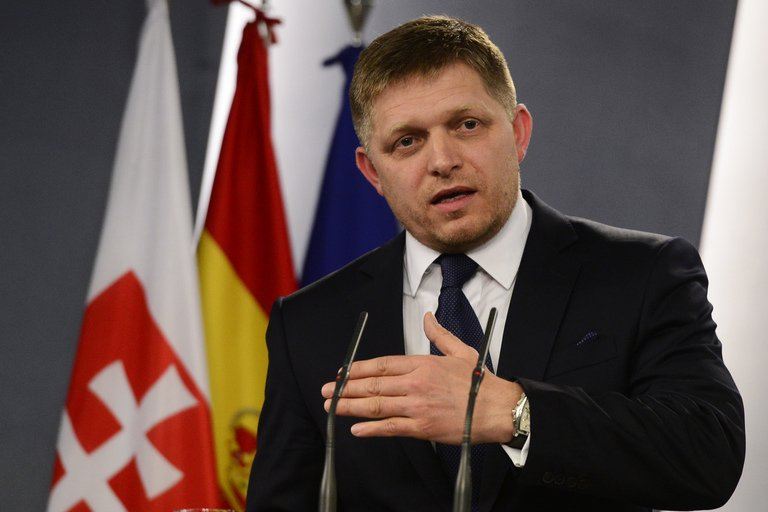
September 06-13
Iran has released six of eight Slovak paragliders held almost four months, Slovak Prime Minister Robert Fico announced Sunday.
But the other two remain prisoners in Iran and Fico suggested the prospects for their release soon were not good.
Fico said the Slovak government made no “financial commitments” to win the release of the six. But he did not say if Slovakia made any non-financial commitments to Iran. Slovakia is a member of the European Union.
Both the prime minister and Foreign Minister Miroslav Lajcak flew to Iran Saturday to secure the release of the six men. Fico did not say why the issue was handled at such a high level and not by career diplomats.
Two years ago, German Foreign Minister Guido Westerwelle flew to Tehran to win the release of two Germans being held prisoner. The Germans later revealed that the Islamic Republic had insisted that Westerwelle fly to Tehran and be photographed with President Ahmadi-nejad before Iran would release the German men.
But Fico did not appear with President Rohani or anyone else in Tehran. The release of the six Slovaks and Fico’s trip to Tehran were not even announced until Fico was back in Slovakia with the six.
Fico told journalists, “Negotiations with Iran were very correct and led to the release of six out of eight Slovak citizens. Two Slovaks are still held in Iran until further allegations are investigated by the Iranian authorities.”
He said he expected further negotiations to be “extremely complicated.”
Fico did not say with whom Slovakia was negotiating, so it was unclear whether the detention was controlled by the Rohani Administration or by the Judiciary alone.
In July, Iran’s Judiciary said it was probing nine people — one Iranian and eight Slovaks — arrested for “illegal activities, including photographing restricted areas” in Esfahan province. That province is home to the large uranium enrichment site at Natanz and the uranium conversion plant just outside the city of Esfahan. But Iran has not yet said what “restricted areas” the men were accused of filming
Friends of the paragliders in Slovakia told Agence France Presse (AFP) the men were not spies, but were traveling to film documentaries from a bird’s-eye view. They said the men were in Iran to collect material for a second film, after making a documentary last year on paragliding over the Himalayas.
Prosecutor General Gholam-Hossain Mohseni-Ejai said in July the men had smuggled in unspecified “illegal equipment.” News reports said they ran into trouble for using two-band walkie-talkies reportedly banned in Iran, as well as cameras designed for extreme sports.
Vladislav Frigo, one of the released paragliders, told reporters, “As far as we know, it’s prohibited to take pictures in Iran while flying lower than 2,300 meters (7,500 feet). We only took pictures from a higher altitude.”
Frigo conceded the group had two-band walkie-talkies, which are banned in Iran, but said, “We didn’t use the prohibited band.”
According to Frigo, the eight were held in one big cell with a TV set and a small corner kitchen, separated from other prisoners. “It was bearable, the prison staff and investigators treated us very nicely,” Frigo said. The men were able to communicate with their families back in Slovakia.
Last year, the Islamic Republic arrested another Slovak on spying charges, made a television program about him, and generally spread his case before the Iranian public—before reversing gear and freeing the man without any trial after 40 days.
The latest group of Slovaks was held more than 100 days and Iran said nothing about holding them until a Slovak website announced they had been detained 50 days.
Friends of the eight said they were all adrenalin junkies who travel the world to film high-flying documentaries.
“They have artistic backgrounds,” said fashion designer Michaela Bednarova, who works with one of the eight.
“One of them is a photographer, one is an architect, another one is a visual artist,” she told AFP in Bratislava earlier this summer. “They made a documentary during their trip to India and they went to Iran to collect material for their second film.”
Their first movie focused on paragliding over the Himalayas in India and aired last year at the Mountains and the City film festival in the Slovak capital.
Another close friend of four of the men, an ex-roommate of one of them, described them as 30-year-old nature lovers who travel on a shoestring budget. “Their only real expenses were flights. Then they would always find humble accommodation with the locals,” he said.
“It must have been a huge misunderstanding — they are definitely no spies,” the Bratislava resident told AFP. “They love different cultures, especially the Middle East. They aren’t your typical Western consumerist types,” he said, adding that the men had also paraglided across Central Europe and Morocco.
Their social media footprints paint a picture of environmentally conscious young men, some of whom are pictured sporting dreadlocks.
The Facebook profile of Majo Krissak, one of the men named by the Slovak media, includes a May 8 post titled “Iran 2013” with a photograph of his paragliding equipment—a harness attached to a parachute-like glider that enables the user to free-fly through the air.
The picture is captioned: “Preparations for the Iran expedition. The first group has already landed in Tehran. The second group is ready to join them on Friday. Keep your fingers crossed so that we fly high and far away!”
Robert Kaucarik, who heads Slovakia’s amateur paragliding club, told AFP that compact extreme sports cameras “are so mainstream in Slovakia that people don’t even realize they can get in trouble for using them [in some other countries].”
He said Iran is considered a desirable destination for paragliders due to its stable climate and interesting terrain. The paraglidingearth.com website recommends 78 sites for the sport in Iran, mostly along its mountainous spines.
